Italian giants Inter Milan are reportedly interested in signing Chelsea´s left-back Emerson Palmieri. The Nerazzurri are ready to offer around €22 million, plus bonuses for Emerson. Chelsea are expected to demand a larger fee for the 25-year-old, who has a contract until 2022.
The prospect of playing under coach Frank Lampard is currently slim. The 25-year-old has not been considered in the Premier League since the end of January this year. Emerson would consider the move because he is not a guaranteed starter at Chelsea and wants the best chance of being Italy’s first choice at next summer’s European Championship.
Inter coach Antonio Conte, previously Emerson’s trainer at Chelsea, still sees the defender as a potential reinforcement. Some weeks ago, Inter already signed Achraf Hakimi, who plays predominantly as right wing-back. Juventus are also interested in Emerson, whose prospects at Chelsea are set to be hindered further by the acquisition of a left-back.
In this scout report, we take a closer look at Emerson’s playing style. In the tactical analysis, we will also figure out how Emerson will fit into Conte´s tactics at Inter.
Role in the system at Chelsea
The Blues primarily set up in a 4-3-3. In possession, Chelsea build from the back patiently and methodically, which Jorginho or Billy Gilmour sitting just ahead of the centre-backs to form a compact passing triangle to circulate possession and invite the opposition to press high. Simultaneously, striker Tammy Abraham will look to push up in order to stretch the opposition defence and pin them back. By doing this, Chelsea encourage the opposition’s attacking and defensive lines to move in opposite directions, allowing space to open up in the middle of the pitch for Chelsea’s wide attackers and more advanced central midfielders to exploit. Once such space is created, Chelsea play quicker and more vertically. The full-backs push up whilst the wingers tuck inside and the advanced midfielders move into the half-spaces, enabling passing triangles to form that allows the team to move the ball forward effectively. In this tactic, Emerson plays an important role as a full-back. He is responsible for runs to provide depth and width on the pitch.

However, after a particularly good start into the 2019/20 campaign, Lampard did not use Emerson as his starting full-back anymore. Since January, he played no single match in the Premier League and only got playing minutes against Leicester City in the FA Cup. In the last six Premier League matches, Emerson was not even in the matchday squad. That is the reason why he wants to move in summer.
Role in the system at Inter
Inter’s team is set up in a 3-5-2 with a single pivot and two wing-backs. Here, the two wing-backs are maybe the most important players as they move between the backline and midfield line in transitions and therefore, play a very important role in Conte’s tactics.

Inter’s head coach Conte seems to be interested in signing the Italian who already played for AS Roma in Serie A. A reason for that might be the fact that Inter’s left side is not that much involved in attacks than the centre or the right side. To become more flexible in the attacking phase of the game, Inter will need a better left wing-back.
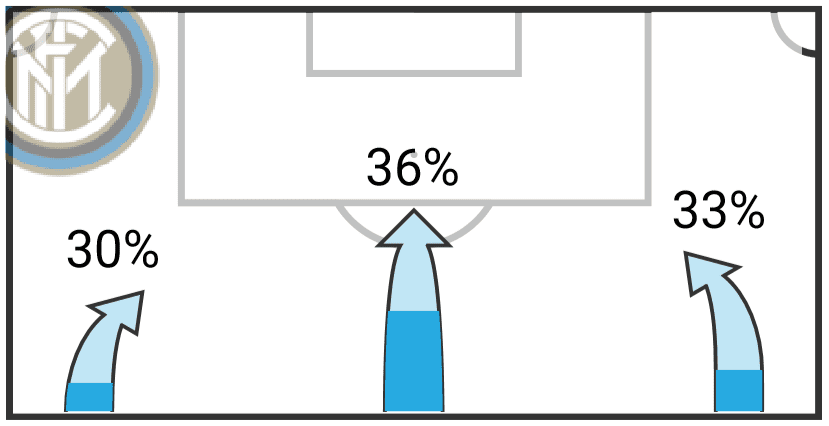
Even if Lampard set up his team with a back-four, Emerson has the abilities to play as a wing-back as you will see in this analysis. Under Conte, Chelsea was set up in a 3-4-3 formation and therefore, they played with wing-backs as well. Under Conte at Chelsea, Emerson played as a left wing-back in 27 matches in the 2018/19 campaign. Also, his heatmap shows his encouraging and hard-working playing style. He is running up and down the wing helping defensive as well as offensive. That is an important attribute for being a wing-back under Conte.
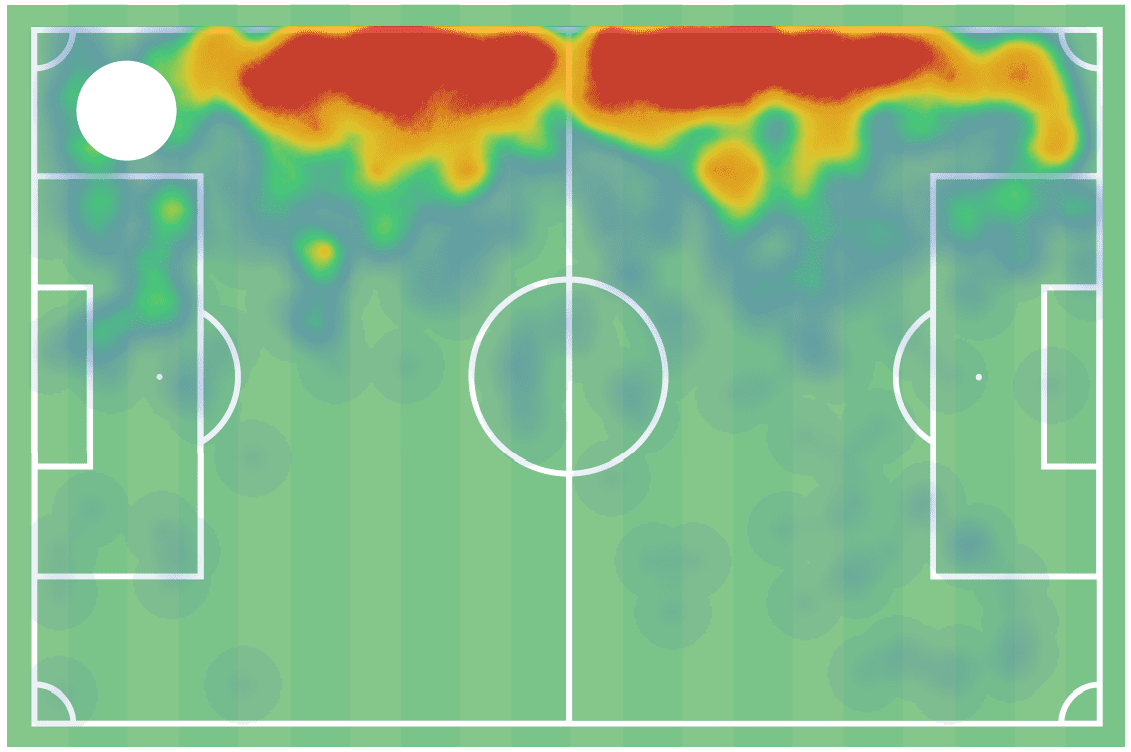
Off-the-ball movement
One of the modern wing-back requirements is the ability to start attacks down the wings with minimal team support. With teams playing expansive football, having wing-backs who cannot catalyze attacking actions puts the team at liability as the team’s attack is forced to repeatedly develop on the opposite side or through a certain action.
Emerson fulfils that exact wing-back requirement. For Chelsea and Italy, Emerson is able to start attacking plays on the wing with often one nearby midfielder or a winger. This not only makes Emerson a versatile player but also adds attacking value to the team as it opens up new avenues for the team to prove the defence.
The most common example of this characteristic is Emerson’s creative use of his teammates. The basic concept is for Emerson to engage in intricate play with his teammates and then to go wide and fade out of the focus of the action. From here, his hopes are that one of his teammates spots the space he is and passes to him.
In the following image, you can see Emerson providing a passing option for Willian by making a run in behind the defensive line using the whole depth of the pitch. After that, he has enough time and space to cross the ball into a dangerous area within Arsenal’s penalty box.
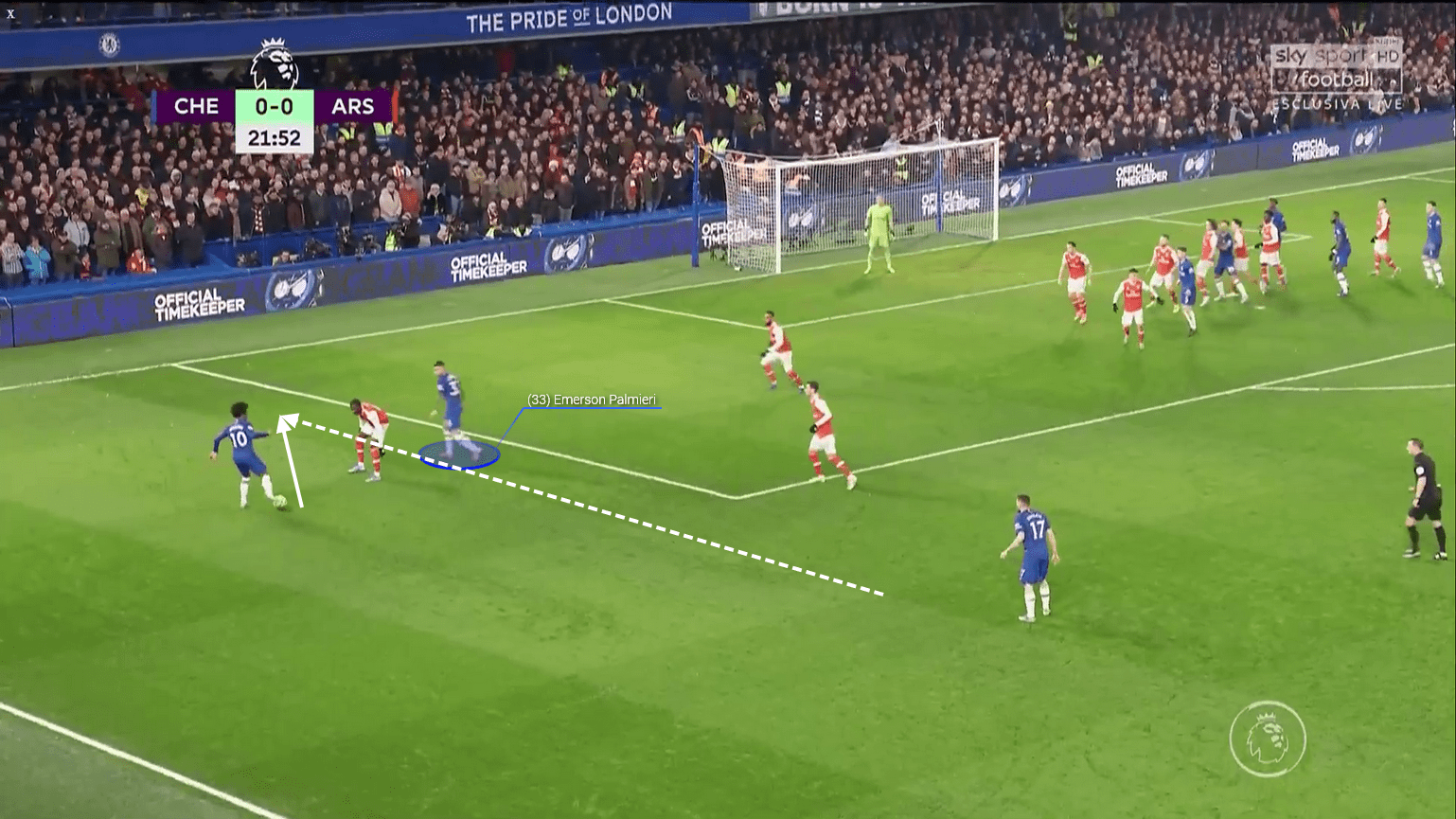
Emerson employs this concept quite often with nearby midfielders and wingers, often initiating one-twos on the wing areas. The key here for Emerson is to situate himself on the wing areas. This allows his attacking patterns to be more effective as the play inwards draws in the opposition formation which opens up space on the wing area for Emerson to exploit.
In the image below, Emerson again provides a passing option for Willian who is under pressure. Thanks to Emerson’s movement, Chelsea have a 2-vs.-1 situation instead of Willian being forced to go in a 1-vs.-1 duel. With space ahead, Emerson will get enough time to look for potential runners in the final third and put in a low cross or cutback. The options there are endless which highlights the extra attacking dimension Emerson brings.
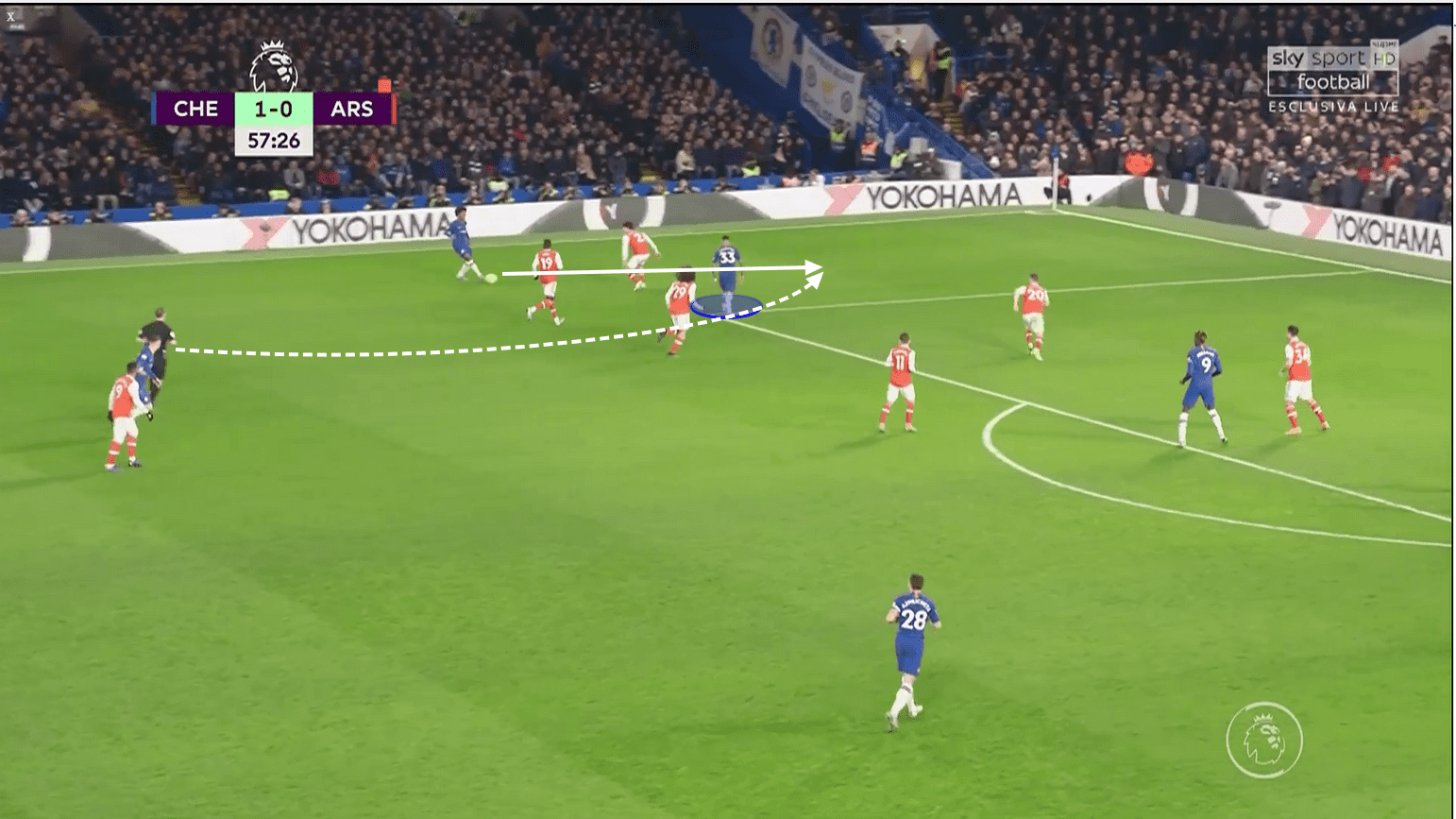
In counter-attacks, Emerson plays a very important role as well. He always pushes high up the pitch to get involved in a counter-attack. Therefore, he provides a passing option for his teammates and is responsible for keeping numerical superiority during the counter-attack. In the image below, we see Chelsea in a counter-attack with Emerson supporting Chelsea´s front three.
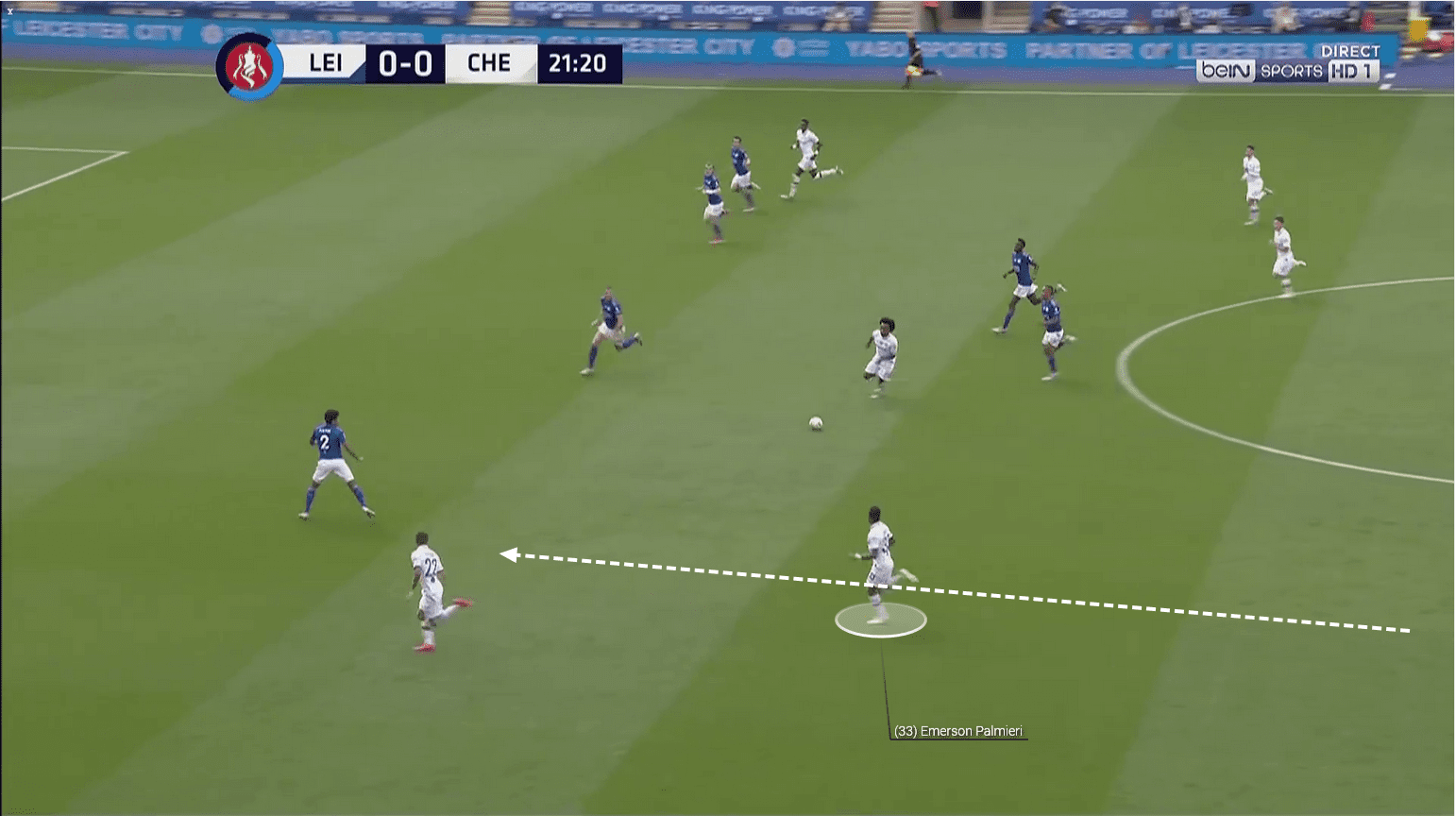
He will play the same role at Inter under Conte. And, as you would expect from a Conte team, Inter is pretty good on the counter-attack. If they win the ball back, the two strikers look for out balls. And then on the break, the strikers are joined by a central midfielder and one of the wing-backs.
In the image below, Inter are on a counter-attack during the game against Juventus. Lautaro Martínez is on the ball exploiting lots of free space. He has several options to choose one. Romelu Lukaku is making a centrally run in behind the defenders. That is why Marcelo Brozović can use the free space opened by the Belgian. Furthermore, Martínez has the option to play out wide onto the left wing because of Ashley Young supporting the attack. If Martínez is able to pass the central midfielder of Juventus, Inter have a 4-vs.-3 situation.
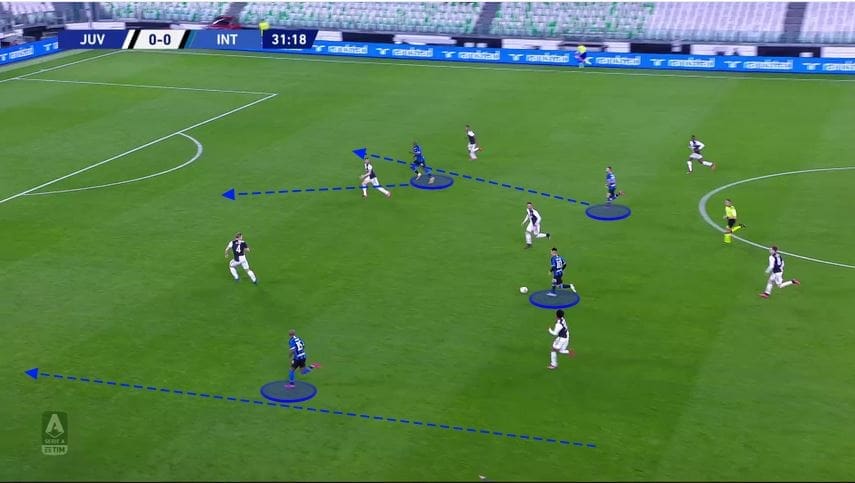
Technically gifted
Another requirement for modern wing-backs is to be comfortable in attacking spaces. Emerson has a versatile first touch, being able to control aerial balls with all areas of the foot. In addition to having excellent control, Emerson is amazingly comfortable in tight spaces.
As such, he is able to maintain attacking positions under intense pressure and is able to attack in tight spaces. This press-resistant ability allows him to attract pressure and release it to the other side. In the image below, Emerson gets the ball from Chelsea’s centre-back. At this point, Leicester is pressing intensively. Emerson is set under pressure but thanks to his composure and his overview he can play the ball into an advanced area on the pitch without playing an easy to defend long-range ball.
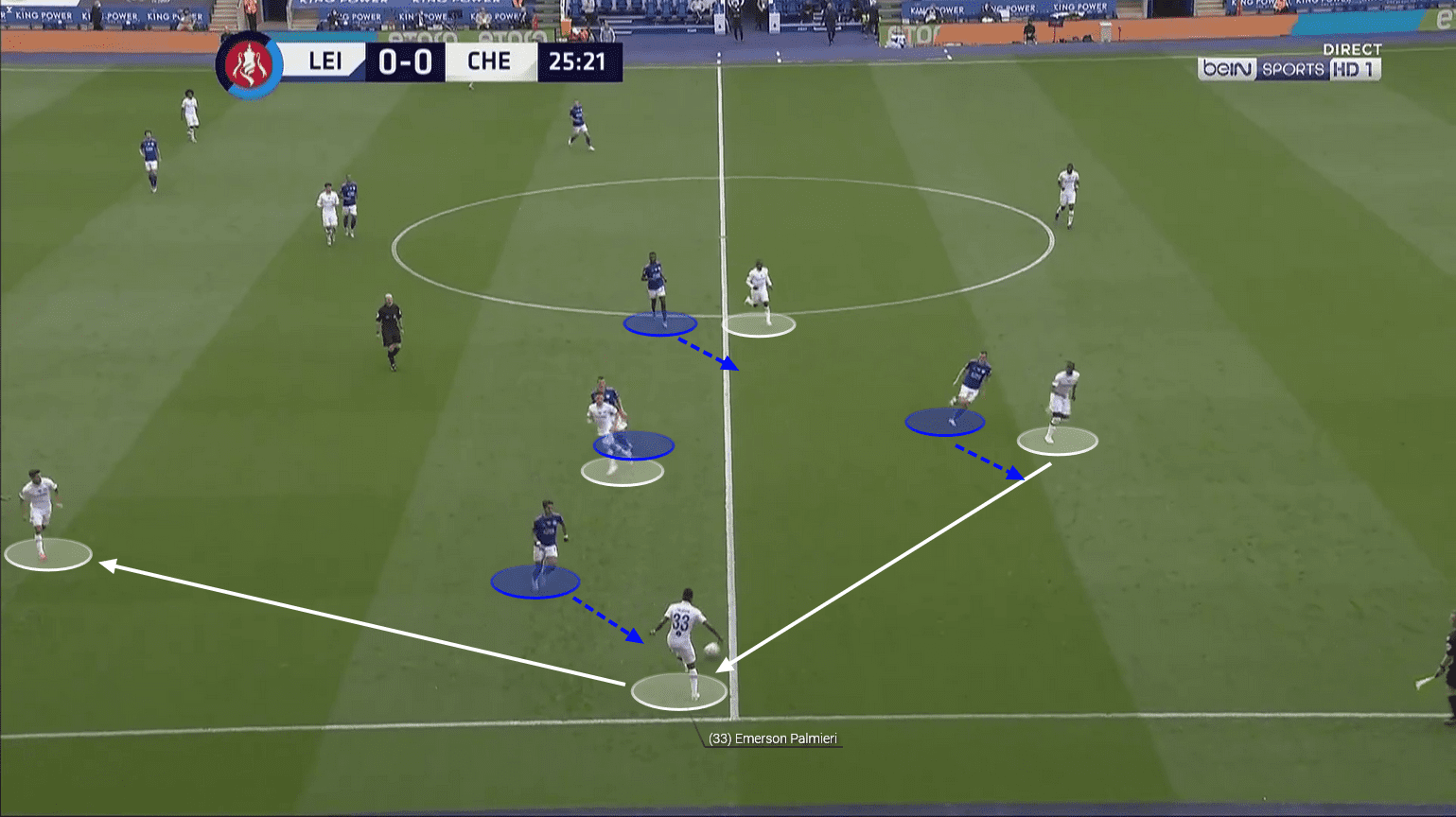
In addition, to using these characteristics to attack indirectly, Emerson also uses his extremely technical profile to dribble. By far, dribbling is one of Emerson’s strengths. Being relatively lightweight, Emerson is extremely comfortable in dribbling in tight places and finding his way out.
Emerson, as a wing-back, dribbles both inwards and outwards – both to great effect. His dribbles inwards attract the formation inwards. This frees up the winger or an attacker to make a move to the wing space. This inversion of positions introduces variability in a team’s attacking structure making Emerson that much more dangerous.
In the following image, Emerson dribbles the ball into a more central area. Christian Pulisic can use the opened area on the wing and forces Bournemouth’s centre-back to follow him. That is why space is opened up in a very dangerous area and Mason Mount can fill it.
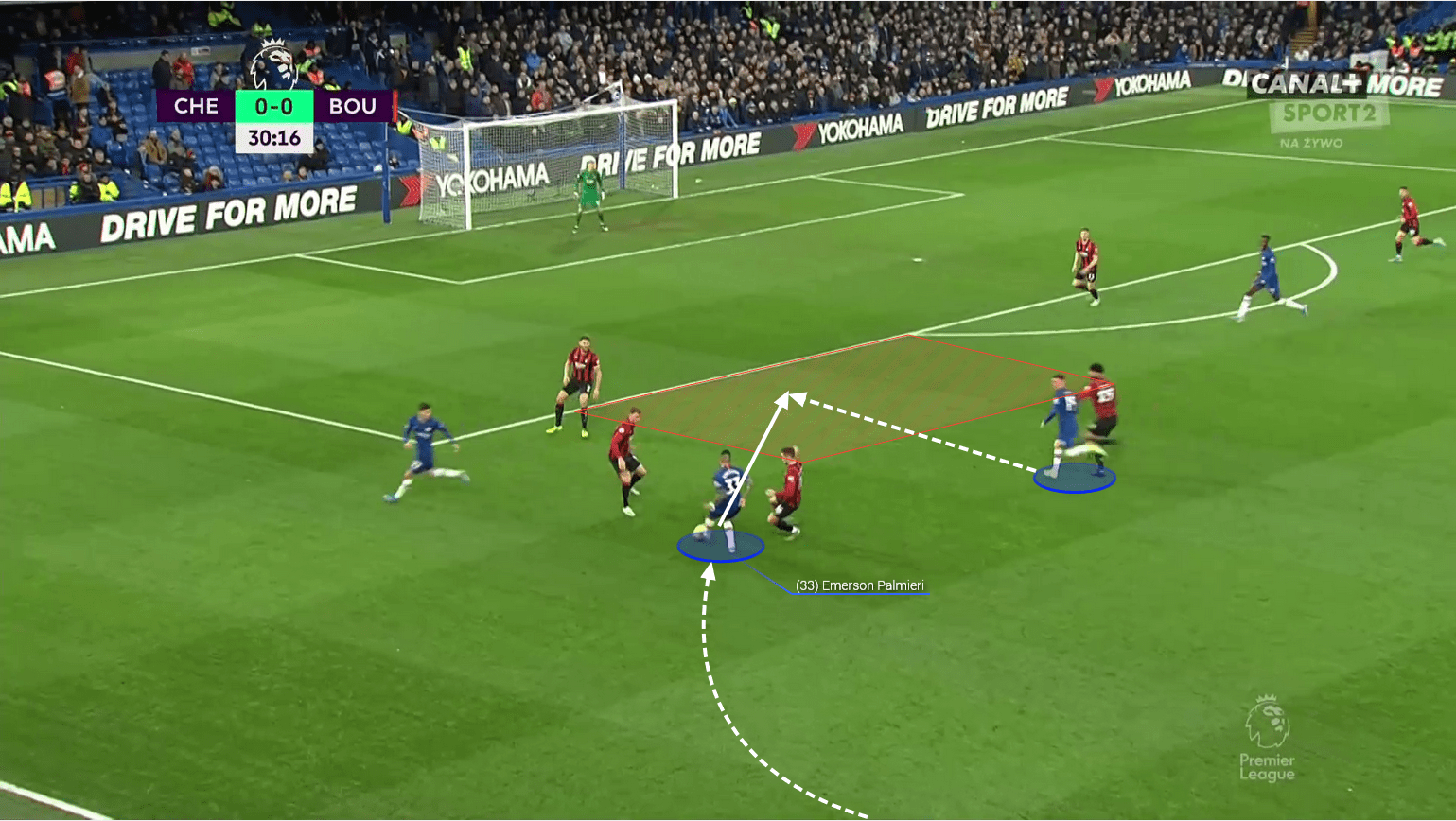
In the next example, Emerson dribbles into a central area again. Chelsea’s left-wing can exploit the space on the sideline and forces a defender to follow him. Then, Chelsea’s forward can exploit lots of space within the opponent’s penalty box. Emerson just has to play a well-timed pass.
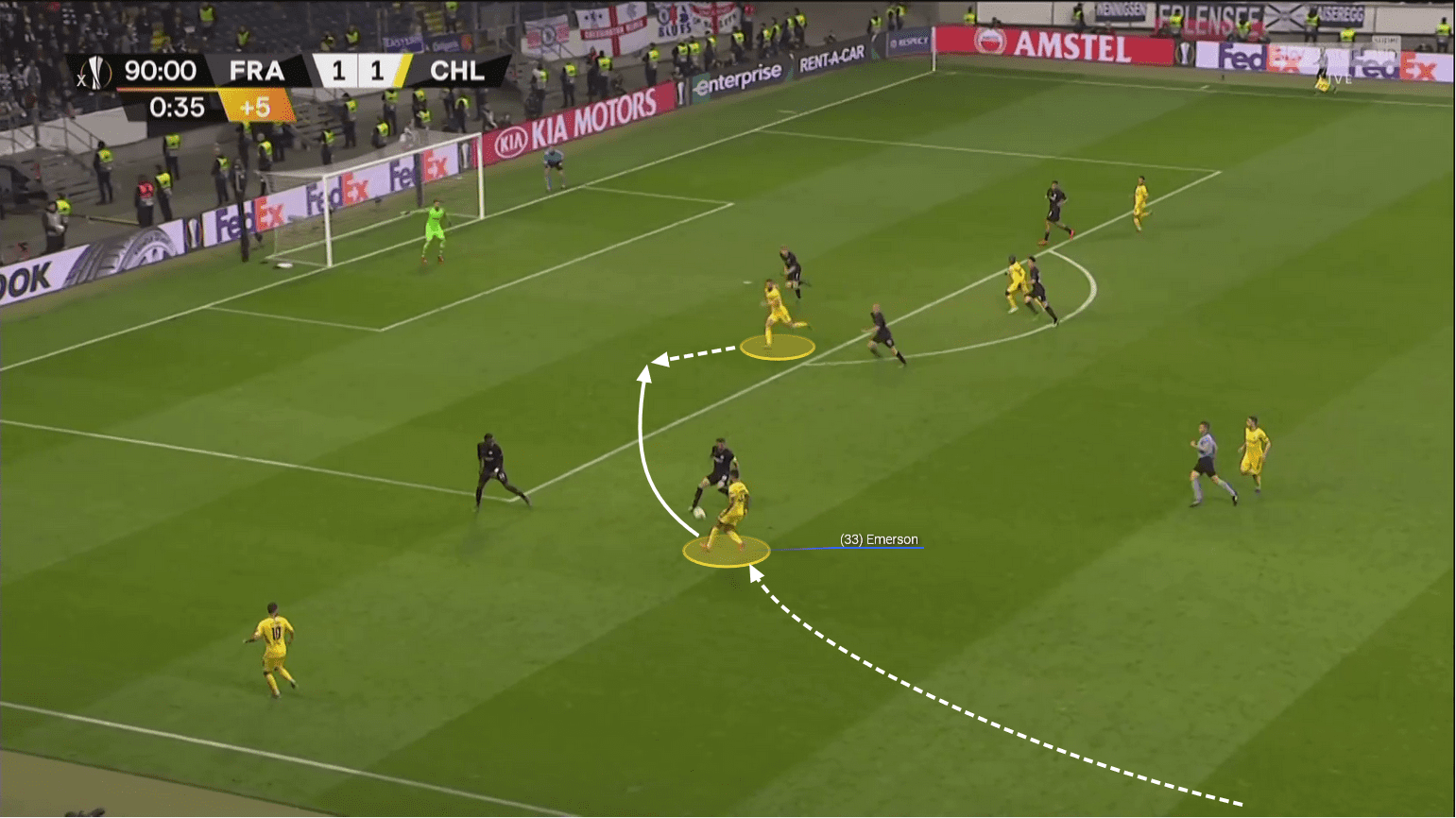
Inter look to use width to create chances. Inter attack in a 3-3-4 formation with either both wing-backs joining the front four or a wing-back switch with a midfielder. With Emerson’s ability to dribble into the centre he will be able to switch positions with a midfielder easily and therefore, Inter will be able to disorganize the opponent’s defensive line. In the image below, we can see this switch. Christian Eriksen goes out wide to get the ball and opens up space. Cristian0 Biraghi starts a run into the space in a central area.

The more dangerous component of Emerson’s dribbling characteristics are his runs on the touchline. Often starting his dribbles from the touchline, Emerson is able to make dribbles on the touchline, often carrying the ball into the final third.
There are various tactical benefits to this movement. First of all, since Emerson is dribbling very wide, he is able to disrupt the positioning of the full-backs and the wide midfielders much more. Since these positions are being disrupted to a greater degree, Emerson can open up space in the defence much easier. This, in turn, allows his teammates to find space in the dangerous positions near the box, allowing the team to have a much better attack.
In the next image, Emerson attracts three opponents and thanks to his dribbling ability he can pass them. After that, he can take advantage of the opponent’s disorganized defensive line. Abraham recognizes the coloured space and only needs to head the ball in.

Compared to Inter’s current wing-backs, Emerson is pretty much average in his dribbling (1,19) and progressive distance. However, new Inter player Hakimi (2,13 successful dribbles) lifts this average as a right wing-back. From the left wing-backs, only Kwadwo Asamoah provides more successful dribbles per 90 (1,63). The other left full-backs Young (0,82) and Biraghi (0,57) provide less successful dribbles per 90 than Emerson.

Intelligence
Aside from starting attacks by one’s own effort and having attacking characteristics, a modern full-back also needs to have an intelligent positioning.
Intelligent positioning allows a player to make certain decisions and actions much easier to act out. Emerson adheres by this policy through his final action positioning. The Italian’s positioning can be described as being productive. What this means is that Emerson is able to yield the most value out of his positions in the attacking play.
One of the key qualities for wing-backs to switch their attacking instincts into a defensive mindset in a quick switch. Emerson, to some degree, shows this trait in his playing abilities. One of his strengths in defending has to be his early anticipation on the flanks. Moulded as an attacking wing-back, his natural instincts are always to look for certain mistakes as to counterattack.
In the following situation, he defends with a lower centre of gravity and so, he is more flexible in his movement. His opponent has no chance to cut in directly or to play a ball into the marked area as Emerson smartly covers it. That is how Emerson forces Nicolas Pépé to go out wide or to make a run to the byline. As Emerson is in the inside track, he can intercept the following cross.

Even if Emerson did not play that many minutes this season, he is by far the best wing-back compared to Inter´s current players if it comes to interceptions. In fact, he provides 2,1 interceptions per 90 minutes. The second-best in this category is Young with 1,8 interceptions per 90 minutes.
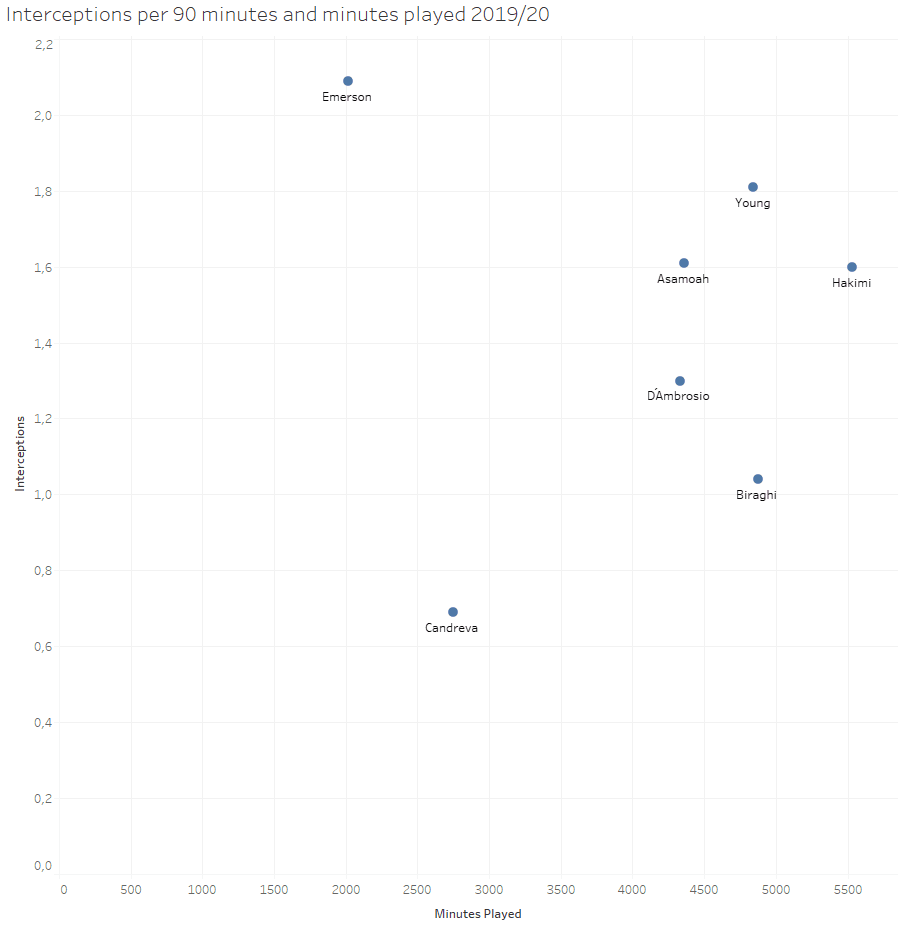
Not only does the Italian do an excellent job at interceptions and blocking passing lanes, but he also gets into position really well. He is blessed with pace which allows him to quickly run and keep the defensive line narrow and well-organized.
In the following image, Emerson is covering depth and is always ready to intercept a pass to Pépé. At the same time, he keeps the backline organized. This compact shape closes down space for Arsenal.

In the defensive transition as well, Conte’s philosophy shines through as Inter’s first priority is getting all men back into the defensive shape. That means that they are difficult to break on as they return into that shape very, very quickly and add more numbers than their opponents have attackers.
We take a look at the game against Juventus. The home team is on a counter-attack. Inter’s priority is to get as many players behind the ball as possible. That is why they make the space tight. Therefore, they have a numerical superiority with 7 defenders against 4 opponents. Most important are the two wing-backs as they have to drop back into the defensive line quickly very often during the game. Emerson perfectly fits into this philosophy as he switches his attacking instincts into a defensive mindset in a quick transition.
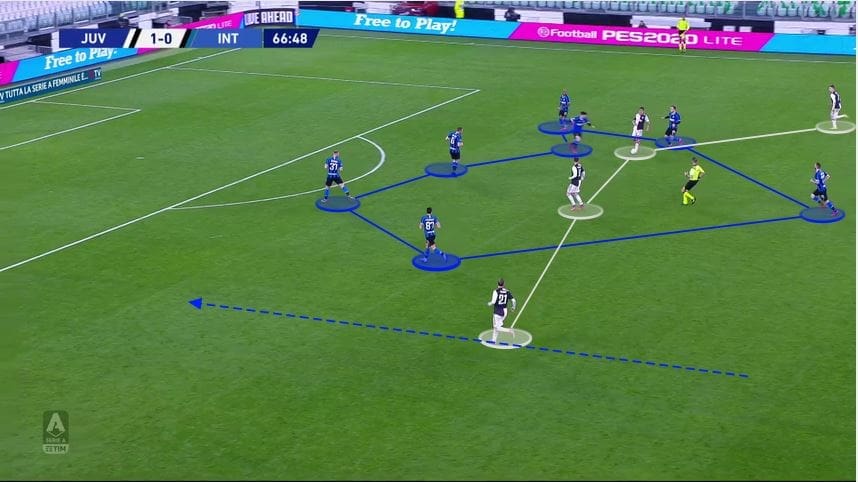
Also, Emerson’s pressing qualities are very impressive. After Hakimi (4,83), he provides the second-most successful pressures per 90 (3,98). The next-best left wing-back is Biraghi with 3,1 successful pressures per 90. Emerson´s successful passing rate of 82,4% is quite good as well. Asamoah is the only left-back with a better rate of 85,4% and therefore, he is the best wing-back in Inter´s squad at all.

1-vs.-1 defending
However, he is not strong in all fields and one deficiency in his weakness is his 1-vs.-1 defending. While the former Roma wing-back is blessed with pace, his discipline in staying compact and narrow against wingers and skilful midfielders is not always present.
As such, Emerson is easily faked out and wingers are able to bypass a defensive player and infiltrate the final third of the box where numerically inferior situations may arise for Emerson’s team. Unlike some other defenders, Emerson is not as strong in the physical department meaning that strong forwards are able to brush him from his pressing. Emerson complements this deficiency through his tactical defending but, as we have seen, lapses of concentration can open up chances for the opposition team.
In the following situation, Emerson lost a 1-vs.-1 duel and now is out of his position. That is why a big space is opened up in Chelsea’s backline and Leicester City can take advantage of it. Leicester’s forward can lay off the ball in start a run into the free space or he can immediately turn and dribble into the space.

Emerson provides only 1,01 won tackles per 90 minutes. Nevertheless, he is better than Inter’s current left-backs Young (0,99), Asamoah (0,94) and Biraghi (0,79). Thanks to his intelligence he often can compensate his weak defensive duels by being right possessed. He is dispossessed only 0,72 times per 90 minutes.

Conclusion
Emerson is no world-class player but he definitely has the class to be a starter in a European top club. After Lampard is not using him anymore, it is understandable that he wants to move. He already knows the Serie A as well as Inter’s head coach Conte with his playing philosophy. Under him, Emerson had his best time as a footballer and at 25, he has still potential to improve. Despite less playing time under Lampard, Emerson provided good stats this season and is able to improve Inter´s current squad. That is why a deal would make sense for all three parties.





Comments